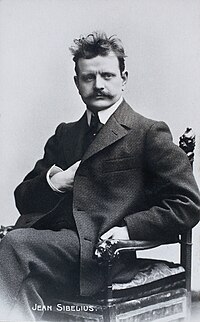The Five Songs, Op. 37,[a] is a collection of Swedish-language art songs for vocal soloist and piano written from 1900 to 1902 by the Finnish composer Jean Sibelius.[b]
| Five Songs, Op. 37 | |
|---|---|
| Song collection by Jean Sibelius | |
 The composer (c. 1900) | |
| Opus | 37 |
| Language | Swedish |
| Composed | 1900–1902; No. 3 orch. 1913 |
| External audio | |
|---|---|
| Sung by Anne Sofie von Otter, accompanied by Bengt Forsberg | |
Constituent songs
editOrdered by catalogue number, the Op. 37 songs are as follows:
- "Den första kyssen" ("The First Kiss"), Op. 37/1 (1900); text by the Finnish poet Johan Ludvig Runeberg[3]
- "Lasse liten" ("Little Lasse"), Op. 37/2 (1902); text by the Finnish poet Zachris Topelius[4]
- "Soluppgång" ("Sunrise"), Op. 37/3 (1902); text by the Swedish poet Tor Hedberg[c][5]
- "Var det en dröm?" ("Was It a Dream?"), Op. 37/4 (1902); text by the Finnish poet Josef Julius Wecksell[6]
- "Flickan kom ifrån sun älsklings möte" ("The Girl Returned Home from Meeting Her Lover"), Op. 37/5 (1901); text by Runeberg[7]
The collection was first published by the Helsinki-based firm Fazer & Westerlund (Helsingfors Nya Musikhandel) from 1901 to 1902. The table below provides additional information about song:
| Song | Tempo | Time | Key | Premiere | Ref. | |||
|---|---|---|---|---|---|---|---|---|
| Soloist | Pianist | Date | Venue | |||||
| No. 1 | Andante (ma non-troppo lento) | Adée Leander-Flodin | Karl Flodin | 22 November 1900 | Solemnity Hall, Helsinki | |||
| No. 2 | Andante | Ida Ekman | Karl Ekman | 8 October 1902 | ||||
| No. 3 | Moderato | 6
8 |
9 October 1902 | |||||
| No. 4 | Moderato | 6
4 |
||||||
| No. 5 | Moderato | January 1901 | Soiree for Otto Lessmann | |||||
Orchestral version of No. 3
editIn 1913, Sibelius arranged "Soluppgång" for vocalist and orchestra.
Notes, references, and sources
editNotes
edit- ^ Because Sibelius's Op. 37 songs are sung in Swedish, this article gives preference to each song's native title, rather than the English translation.
- ^ All but a few of Sibelius's songs are settings of Swedish-language poems (quantitatively, his favorite poets were Ernst Josephson, Johan Ludvig Runeberg, Viktor Rydberg, and Karl August Tavaststjerna)[1] and are with piano accompaniment. While many are of high quality, they largely have been neglected outside the Nordic realm, due to the limited coverage (in terms of number of speakers) of Swedish (relative to, for example, German or French).[2]
- ^ A preliminary/alternative version of "Soluppgång" ("Sunrise") is extant; its catalogue designation is JS 87.
References
edit- ^ Layton 1993, pp. 160–161.
- ^ Layton 1993, pp. 159–160.
- ^ Barnett 2007, p. 405; Dahlström 2003, pp. 166–167.
- ^ Barnett 2007, p. 406; Dahlström 2003, pp. 168–169.
- ^ Barnett 2007, p. 406; Dahlström 2003, pp. 169–171, 546–547.
- ^ Barnett 2007, p. 406; Dahlström 2003, pp. 171–172.
- ^ Barnett 2007, p. 406; Dahlström 2003, pp. 172–174.
- ^ Dahlström 2003, p. 166.
- ^ Dahlström 2003, p. 168.
- ^ Dahlström 2003, p. 169.
- ^ Dahlström 2003, p. 171.
- ^ Dahlström 2003, p. 173.
Sources
edit- Barnett, Andrew (2007). Sibelius. New Haven, Connecticut: Yale University Press. ISBN 978-0-300-16397-1.
- Dahlström, Fabian [in Swedish] (2003). Jean Sibelius: Thematisch-bibliographisches Verzeichnis seiner Werke [Jean Sibelius: A Thematic Bibliographic Index of His Works] (in German). Wiesbaden: Breitkopf & Härtel. ISBN 3-7651-0333-0.
- Layton, Robert (1993) [1965]. Sibelius. (The Master Musicians Series) (4th ed.). New York: Schirmer Books. ISBN 0028713222.
External links
edit- Five Songs, Op. 37: Scores at the International Music Score Library Project